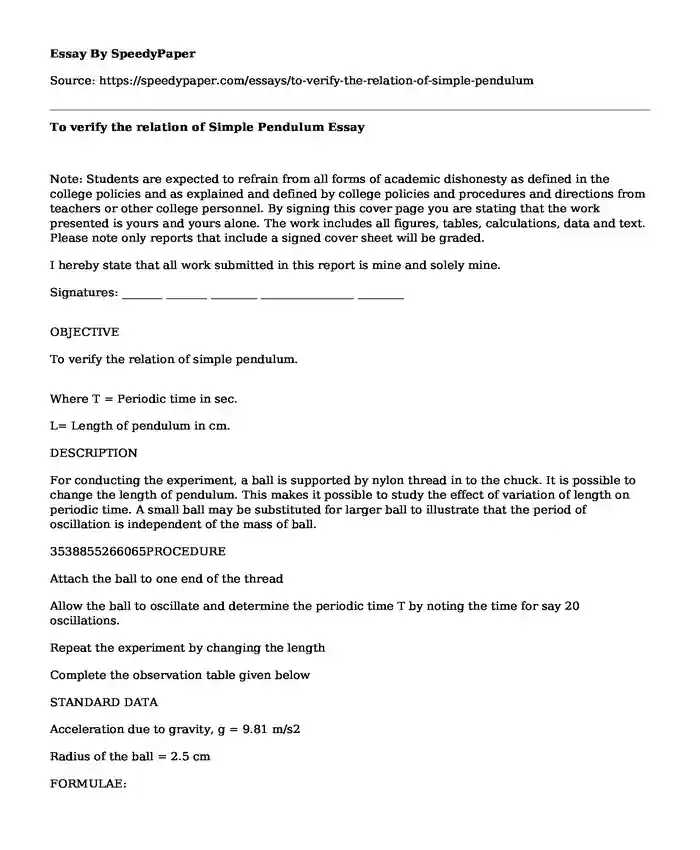
| Type of paper: | Report |
| Categories: | Leadership analysis Finance Society World Disorder |
| Pages: | 3 |
| Wordcount: | 639 words |
Note: Students are expected to refrain from all forms of academic dishonesty as defined in the college policies and as explained and defined by college policies and procedures and directions from teachers or other college personnel. By signing this cover page you are stating that the work presented is yours and yours alone. The work includes all figures, tables, calculations, data and text. Please note only reports that include a signed cover sheet will be graded.
I hereby state that all work submitted in this report is mine and solely mine.
Signatures: _______ _______ ________ ________________ ________
OBJECTIVE
To verify the relation of simple pendulum.
Where T = Periodic time in sec.
L= Length of pendulum in cm.
DESCRIPTION
For conducting the experiment, a ball is supported by nylon thread in to the chuck. It is possible to change the length of pendulum. This makes it possible to study the effect of variation of length on periodic time. A small ball may be substituted for larger ball to illustrate that the period of oscillation is independent of the mass of ball.
3538855266065PROCEDURE
Attach the ball to one end of the thread
Allow the ball to oscillate and determine the periodic time T by noting the time for say 20 oscillations.
Repeat the experiment by changing the length
Complete the observation table given below
STANDARD DATA
Acceleration due to gravity, g = 9.81 m/s2
Radius of the ball = 2.5 cm
FORMULAE:
Time Period, T Actual =t / nSec.
2181225133985
448881563500Time Period, T Theo. =Sec.
Where
T =Time taken by 'n ' oscillations.
N =Nos. of oscillation. INCLUDEPICTURE "https://i.stack.imgur.com/PFvkb.jpg" \* MERGEFORMATINET
L =Length of pendulum from the center of the ball in cm
OBSERVATION & CALCULATION TABLE:
# Pendulum Length Oscillations Number Oscillations Time Actual Period Theoretical period Error
1 0.66 20 32.72 1.636 1.630 0.34%
2 0.575 20 30.04 1.502 1.522 1.30%
3 0.475 20 28.76 1.438 1.383 3.97%
4 0.38 20 24.49 1.2245 1.237 1.02%
5 0.27 20 20.78 1.039 1.043 0.36%
Calculation sample:
tActual=Ocillations TimeOscillation number= 32.7220=1.636 sectTheoretical=2pLg=2p0.669.81=1.630
Graph: T Theoretical Vs T Actual
Results
Results of counted number of oscillations (20 oscillations) made by the swinging mass were recorded. Also, the time taken during the oscillations was as well recorded.
Final calculations were carried out and the calculated periodic time (T) was found to be approximately 1.363s while the theoretical/ideal periodic time is 1.630s.
DISCUSSION
Following the results obtained there were discrepancies between theoretical and calculated periodic time (T). This might have been caused by various physical factors; human errors (accuracy), this might have been the parallax measurement of the parameters. There might be some errors encountered due to erroneous instruments. For instance, a stopwatch might be the cause of errors instead this errors would be minimized by using the photo sensors which are more precised.
Measurement of amplitude (the length of the string) in a precised and more accurately would also minimize such errors. If a photo timer would be used to measure the periods the sources of these errors would be minimized. Precise devices for this measurements which were to be taken from the laboratory. Besides, there might be systematic errors encountered with during the experiment. The errors might include air resistance of the mass and string producing the oscillations.
Concerning the variable periodic time of which we theoretically know that this measured periodic time should be the same all through since the number of oscillations were 20.
CONCLUSION
In conclusion, we agreed that time was the mostly affected parameter by the variation of string's length. In accordance with the data obtained an analysis of the trend claimed that as the length of the string decreased the periodic time also decreased. The amplitude did not affect time. It was also deduced that the surroundings were not perfect for the experiment thus some friction was experienced by the ball producing the air resistance. The theoretical value is nearly the same to the calculated value thus such minor discrepancies are due to nature, friction and the resistance the air particles to the swinging ball.
References
Nelson, R. A., & Olsson, M. G. (1986). The pendulum-Rich physics from a simple system. American Journal of Physics, 54(2), 112-121.
Cite this page
To verify the relation of Simple Pendulum. (2022, Dec 30). Retrieved from https://speedypaper.net/essays/to-verify-the-relation-of-simple-pendulum
Request Removal
If you are the original author of this essay and no longer wish to have it published on the SpeedyPaper website, please click below to request its removal:
- Essay Example: Critiques of Influencing Health Care in the Legislative Arena
- Essay Sample: A Comparison of College and High School Students
- Essay Example: Donald Trump Is a Controversy
- Essay Example on American Medical News
- Global Perspectives in Managing People - Essay Example for Students
- Essay Example: Nursing Perceptions
- Paper Example. Plan for a Hearing Aid Business
Popular categories




